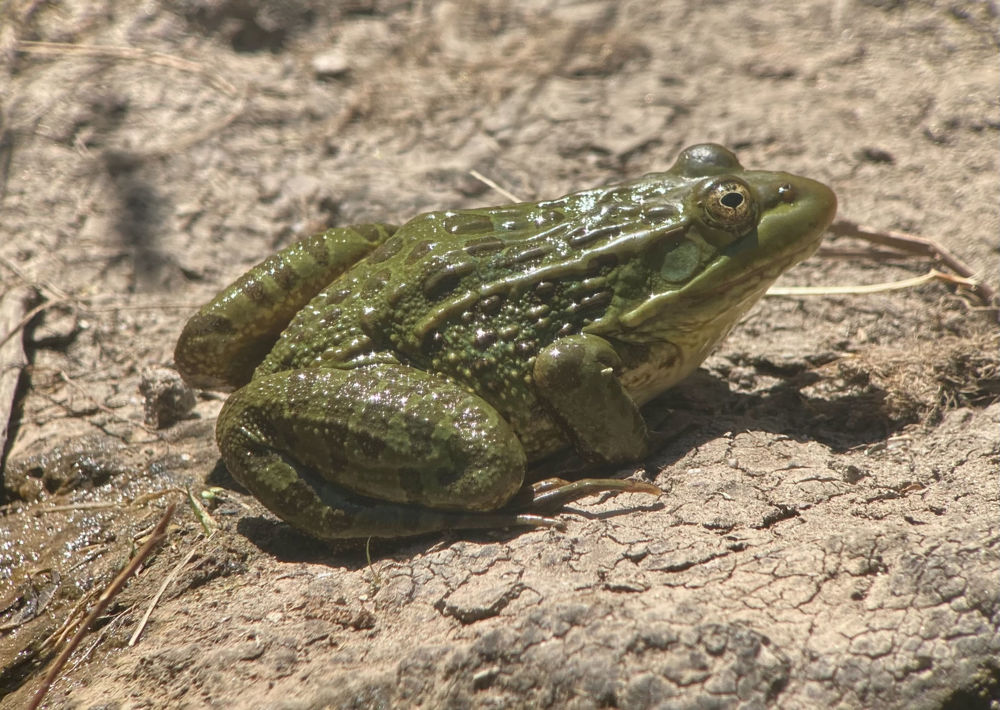Departure Date: May 14 - 24, 2025
Compiled By: Barry Zimmer
Trip Leaders: Barry Zimmer
Toll Free: 800.328.8368
Phone: 512.328.5221
Spring Grand Arizona 5/14/2025-5/24/2025

Spring Grand Arizona
Once again, this year’s Spring Grand Arizona tour had it all. We tallied ten species of hummingbirds (including two Mexican vagrants), seven species of owls, several nice rarities, and had great looks at virtually all of our more “expected” targets. Additionally, migration was exceptional and late with many species rarely seen on this tour added to our trip list, and rather staggering numbers of some more common species tallied. Very good (=cooler than normal) weather prevailed throughout. This was certainly one of our most successful spring trips ever! Our tour began in Tucson with a visit to the famed Arizona Sonoran Desert Museum. The temperatures were surprisingly pleasant, and we tallied five Costa’s Hummingbirds (including one adult male), Gila Woodpecker, Verdin, Brown-crested Flycatcher, Cactus Wren at our feet, brilliant Hooded Orioles, the localized Rufous-winged Sparrow at point-blank range, Green-tailed Towhee, and migrant Townsend’s, Black-throated Gray, and Wilson’s warblers. A Gilded Flicker on our way back to the hotel was a great bonus. This was a nice start to our trip indeed! The next morning, we headed down to Green Valley, with our first stop at Desert Meadow Park before heading up into the Madera Canyon. There we enjoyed several nice species, including Gambel’s Quail, Inca Dove, Costa’s and Broad-billed hummingbirds, Vermilion Flycatcher, Bell’s Vireo, Brewer’s (late) and Lark sparrows, Abert’s Towhee, Lucy’s Warbler, Nashville Warbler (rare), and Blue Grosbeak. Our first stop in Madera was at the Madera Kubo, where a rare Berylline Hummingbird had been recently spotted. A variety of feeders and water features there hosted many species, including Wild Turkey, Rivoli’s Hummingbird, Acorn Woodpecker, Mexican Jay, Bridled Titmouse, the always angry-looking Yellow-eyed Junco, stunning Painted Redstarts, Black-headed Grosbeak, and Hepatic Tanager. 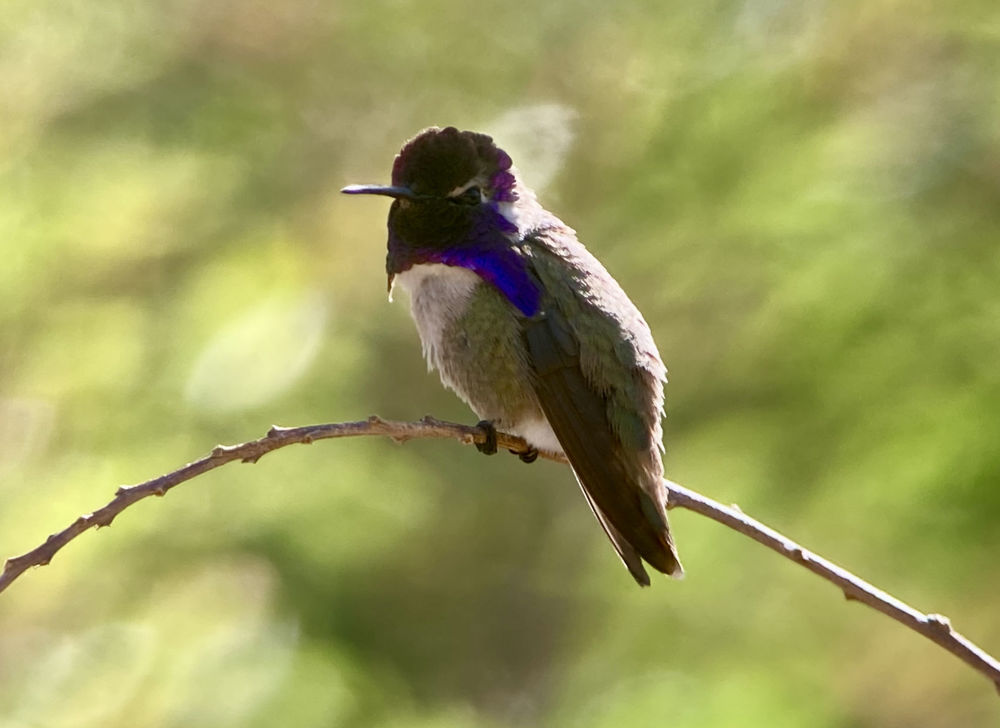 Costa's Hummingbird ©Barry Zimmer By mid-morning we were headed to the upper parking area of Madera Canyon in search of the iconic Elegant Trogon. Despite a lengthy hike and some reports of trogon sightings by others, we did not locate one on this day. We did, however, have incredible views of the incomparable Red-faced Warbler (seldom seen low down in this canyon), in addition to other new species such as Dusky-capped Flycatcher, Hammond’s Flycatcher, Western Flycatcher, Swainson’s and Hermit thrushes, and Black-throated Gray and Grace’s warblers. After lunch, we headed up Box Canyon hoping to find the extremely localized and highly-sought Five-striped Sparrow. Luck was on our side, as we had point-blank views of this prize within ten minutes. On our way back to Tucson for a mid-afternoon break, we paused near Sahuarita to look for Harris’s Hawk. We quickly located a family group of four birds in a pine, enjoying nice scope looks, including a copulation by the adults!
Costa's Hummingbird ©Barry Zimmer By mid-morning we were headed to the upper parking area of Madera Canyon in search of the iconic Elegant Trogon. Despite a lengthy hike and some reports of trogon sightings by others, we did not locate one on this day. We did, however, have incredible views of the incomparable Red-faced Warbler (seldom seen low down in this canyon), in addition to other new species such as Dusky-capped Flycatcher, Hammond’s Flycatcher, Western Flycatcher, Swainson’s and Hermit thrushes, and Black-throated Gray and Grace’s warblers. After lunch, we headed up Box Canyon hoping to find the extremely localized and highly-sought Five-striped Sparrow. Luck was on our side, as we had point-blank views of this prize within ten minutes. On our way back to Tucson for a mid-afternoon break, we paused near Sahuarita to look for Harris’s Hawk. We quickly located a family group of four birds in a pine, enjoying nice scope looks, including a copulation by the adults! 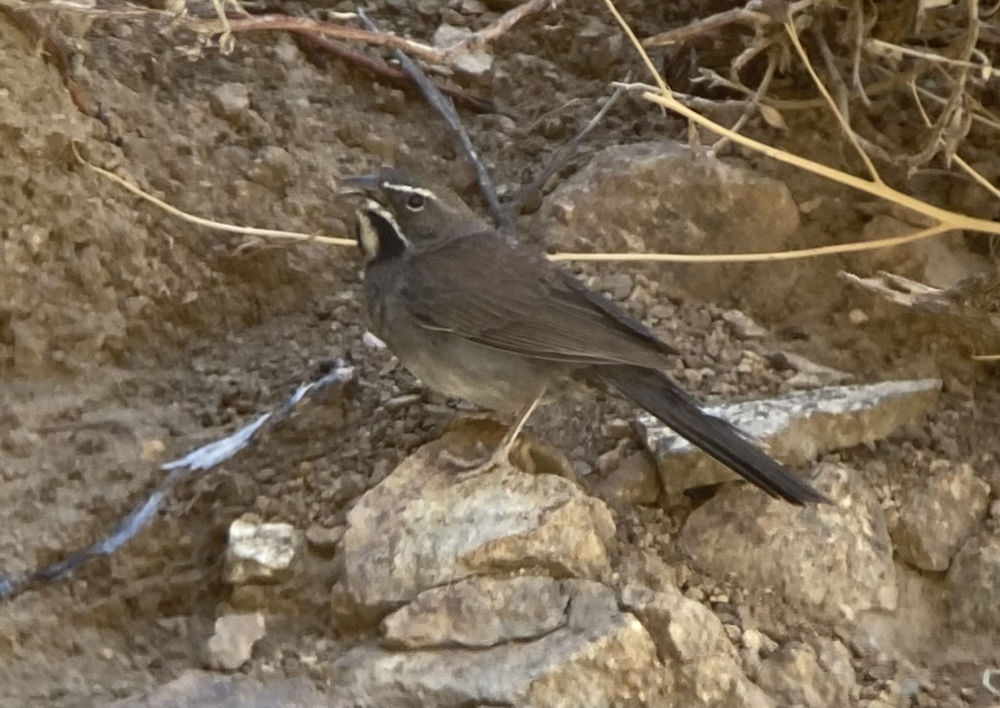 Five-striped Sparrow ©Barry Zimmer That evening, we returned to the Santa Rita Mountains for our first owling excursion. On the way, we spied a Crested Caracara (rare here) perched atop a saguaro. Lesser Nighthawks, along with Violet-green Swallows, swarmed over the desert on our way up into the canyon, allowing wonderful views. We topped things off with scope studies of a tiny Elf Owl at its nest and quick, but close, views of a Western Screech-Owl. This was a wonderful first full day! The next day found us back in the Santa Rita Mountains, this time focusing all our efforts on finding a trogon. Our nearly mile-long hike up the canyon was rewarded with the best views ever of this most iconic bird of southeast Arizona. We had a male as close as ten feet at times, and enjoyed watching it for over ten minutes. It would ultimately be voted the favorite bird of the tour! On our way back down the canyon, we stopped again at the Madera Kubo, and this time the rare Berylline Hummingbird showed up in quick order. At nearby Santa Rita Lodge, we tallied an Arizona Woodpecker and a male Bronzed Cowbird.
Five-striped Sparrow ©Barry Zimmer That evening, we returned to the Santa Rita Mountains for our first owling excursion. On the way, we spied a Crested Caracara (rare here) perched atop a saguaro. Lesser Nighthawks, along with Violet-green Swallows, swarmed over the desert on our way up into the canyon, allowing wonderful views. We topped things off with scope studies of a tiny Elf Owl at its nest and quick, but close, views of a Western Screech-Owl. This was a wonderful first full day! The next day found us back in the Santa Rita Mountains, this time focusing all our efforts on finding a trogon. Our nearly mile-long hike up the canyon was rewarded with the best views ever of this most iconic bird of southeast Arizona. We had a male as close as ten feet at times, and enjoyed watching it for over ten minutes. It would ultimately be voted the favorite bird of the tour! On our way back down the canyon, we stopped again at the Madera Kubo, and this time the rare Berylline Hummingbird showed up in quick order. At nearby Santa Rita Lodge, we tallied an Arizona Woodpecker and a male Bronzed Cowbird. 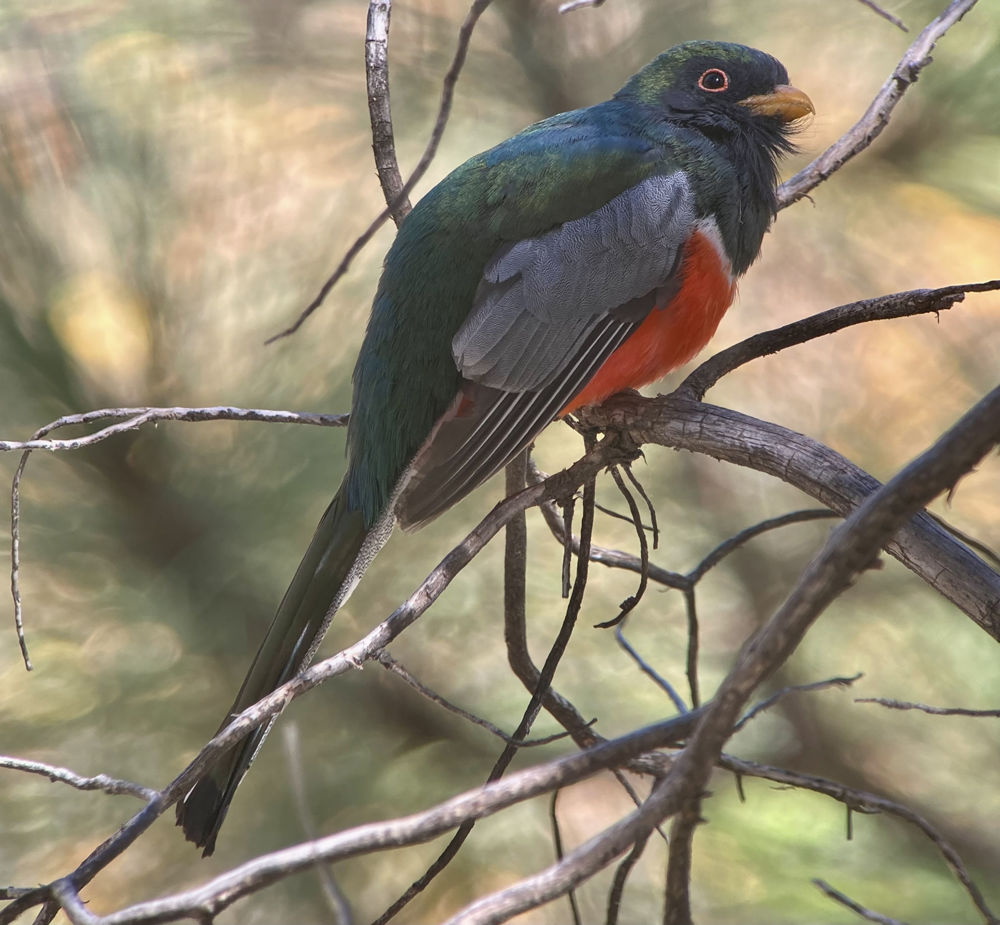 Elegant Trogon ©Barry Zimmer After a superb lunch at Elvira’s in Tubac, we stopped along nearby Bridge Road. Gray Hawk, Tropical Kingbird, countless Phainopeplas, Summer Tanager, and Yellow-breasted Chat were among the many species seen there in the early afternoon. We opted for a brief stop at Las Lagunas de Anza in Nogales before heading to the hotel for a well-deserved break. Green Heron, Gray and Swainson’s hawks, another Tropical Kingbird, Common Yellowthroat, and Song Sparrow were all added to our list. The following morning, we ventured out Ruby Road as far as the entrance to Sycamore Canyon. It was largely quiet along the way with Rock Wren, Rufous-crowned Sparrow, and Canyon Towhee being the only new birds. However, upon arriving at Sycamore Canyon, we found an oak tree that was freshly leafing out, and it was swarming with birds. Eight Townsend’s Warblers, three rare Hermit Warblers, and a stunning male Varied Bunting (thanks Michelle!) topped the list, but that one tree had thirteen species of birds in it! Additionally, a pair of Zone-tailed Hawks soared right overhead!
Elegant Trogon ©Barry Zimmer After a superb lunch at Elvira’s in Tubac, we stopped along nearby Bridge Road. Gray Hawk, Tropical Kingbird, countless Phainopeplas, Summer Tanager, and Yellow-breasted Chat were among the many species seen there in the early afternoon. We opted for a brief stop at Las Lagunas de Anza in Nogales before heading to the hotel for a well-deserved break. Green Heron, Gray and Swainson’s hawks, another Tropical Kingbird, Common Yellowthroat, and Song Sparrow were all added to our list. The following morning, we ventured out Ruby Road as far as the entrance to Sycamore Canyon. It was largely quiet along the way with Rock Wren, Rufous-crowned Sparrow, and Canyon Towhee being the only new birds. However, upon arriving at Sycamore Canyon, we found an oak tree that was freshly leafing out, and it was swarming with birds. Eight Townsend’s Warblers, three rare Hermit Warblers, and a stunning male Varied Bunting (thanks Michelle!) topped the list, but that one tree had thirteen species of birds in it! Additionally, a pair of Zone-tailed Hawks soared right overhead! 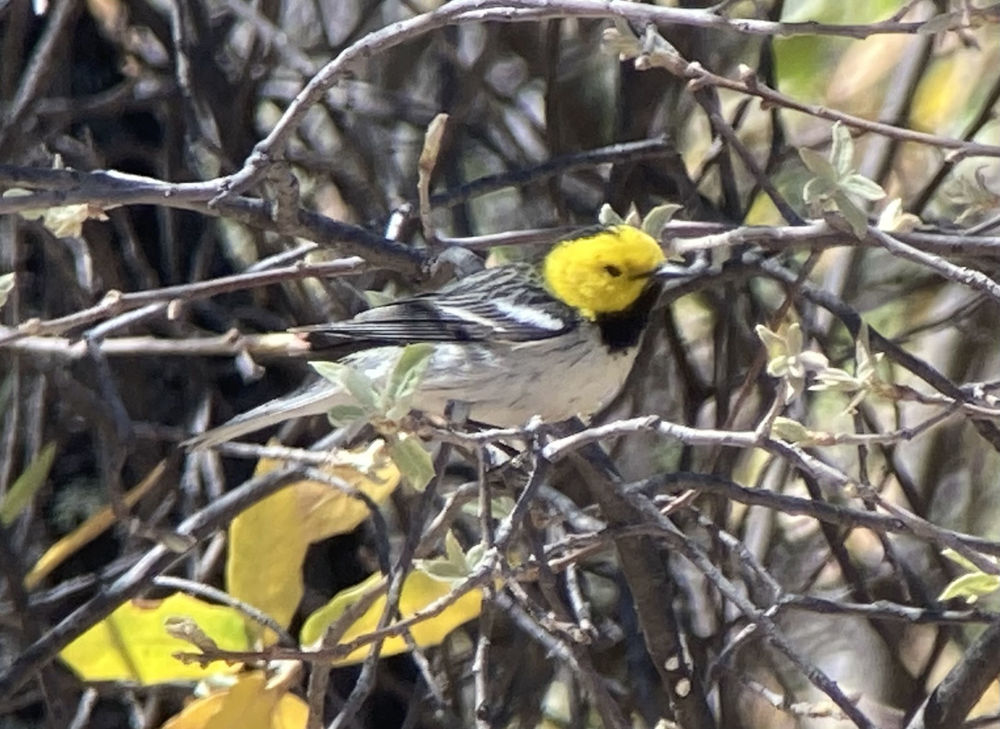 Hermit Warbler ©Barry Zimmer Following lunch (and the greatest apple pie in the world!), we opted for a relaxing afternoon at the Paton Hummingbird Center in Patagonia. We quickly landed our primary target, the flashy Violet-crowned Hummingbird, with Ladder-backed Woodpecker, Northern Beardless-Tyrannulet, and a rare Rose-breasted Grosbeak thrown in for good measure. We ended the day with some birding in nearby Harshaw Canyon. Scope views of Thick-billed Kingbird were particularly memorable, but we also had a Gray Hawk on a nest and a migrant Olive-sided Flycatcher. Another great day in the books! Day Five found us back in Patagonia, starting out at the famous Patagonia Roadside Rest Area, where several White-throated Swifts rocketed overhead, while a return to Harshaw Canyon produced a rare sighting of Vaux’s Swift. Heading eastward through the nearby Sonoita Grasslands, we tallied the newly-split Chihuahuan Meadowlark, as well as Horned Lark, a very late Lark Bunting, and many Lark Sparrows. After lunch, we headed to Willcox, where several rarities had been recently reported. We enjoyed an excellent visit there with ten species of shorebirds (including a very rare American Golden Plover, American Avocet, Black-necked Stilt, Baird’s Sandpiper, and Wilson’s and Red-necked phalaropes among others), Mexican Duck, Cinnamon Teal, White-faced Ibis, and Franklin’s Gull. In total, we added twenty species to our rapidly growing list at this site. We rounded out the day with a late afternoon visit to Ash Canyon south of Sierra Vista. There, we found the hoped-for Lucifer Hummingbird in record-breaking time—one minute after arrival. Brilliant Anna’s Hummingbirds, many Broad-tailed Hummingbirds, tons of Western Tanagers, and Bullock’s and Scott’s orioles were among the other more noteworthy species.
Hermit Warbler ©Barry Zimmer Following lunch (and the greatest apple pie in the world!), we opted for a relaxing afternoon at the Paton Hummingbird Center in Patagonia. We quickly landed our primary target, the flashy Violet-crowned Hummingbird, with Ladder-backed Woodpecker, Northern Beardless-Tyrannulet, and a rare Rose-breasted Grosbeak thrown in for good measure. We ended the day with some birding in nearby Harshaw Canyon. Scope views of Thick-billed Kingbird were particularly memorable, but we also had a Gray Hawk on a nest and a migrant Olive-sided Flycatcher. Another great day in the books! Day Five found us back in Patagonia, starting out at the famous Patagonia Roadside Rest Area, where several White-throated Swifts rocketed overhead, while a return to Harshaw Canyon produced a rare sighting of Vaux’s Swift. Heading eastward through the nearby Sonoita Grasslands, we tallied the newly-split Chihuahuan Meadowlark, as well as Horned Lark, a very late Lark Bunting, and many Lark Sparrows. After lunch, we headed to Willcox, where several rarities had been recently reported. We enjoyed an excellent visit there with ten species of shorebirds (including a very rare American Golden Plover, American Avocet, Black-necked Stilt, Baird’s Sandpiper, and Wilson’s and Red-necked phalaropes among others), Mexican Duck, Cinnamon Teal, White-faced Ibis, and Franklin’s Gull. In total, we added twenty species to our rapidly growing list at this site. We rounded out the day with a late afternoon visit to Ash Canyon south of Sierra Vista. There, we found the hoped-for Lucifer Hummingbird in record-breaking time—one minute after arrival. Brilliant Anna’s Hummingbirds, many Broad-tailed Hummingbirds, tons of Western Tanagers, and Bullock’s and Scott’s orioles were among the other more noteworthy species. 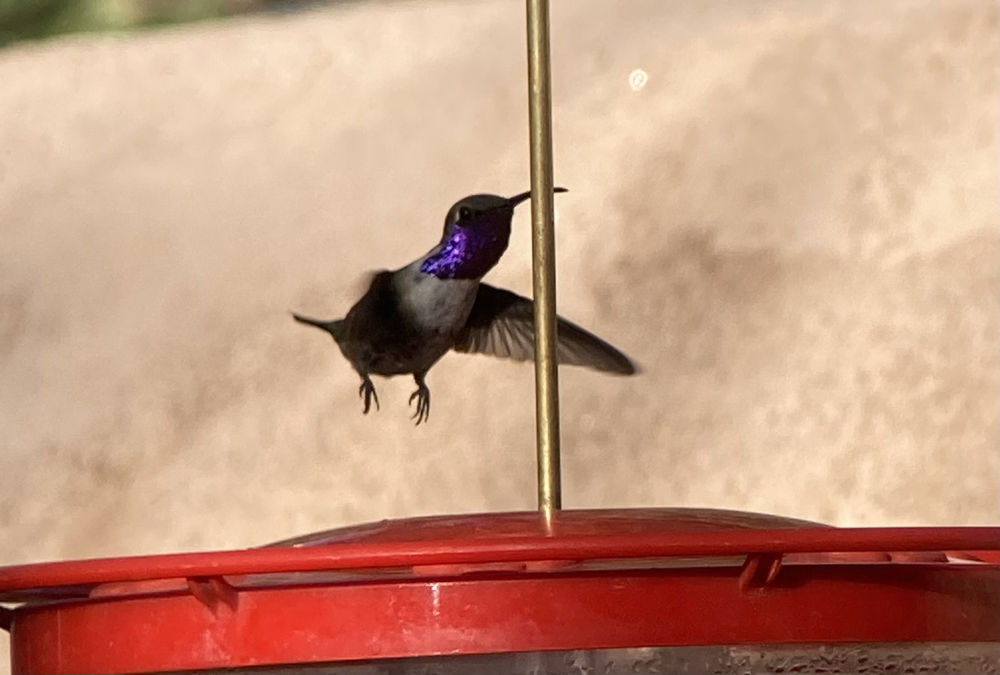 Lucifer Hummingbird ©Barry Zimmer The next day, we visited scenic Carr Canyon in the Huachuca Mountains. This is typically my favorite day of the tour, and on this day it did not disappoint. The highlights were almost too numerous to mention, but included Zone-tailed Hawk, Greater Pewee, several Buff-breasted Flycatchers, Hutton’s and Plumbeous vireos, Brown Creeper, Bushtit, Eastern Bluebird, Olive Warbler, Virginia’s Warbler, Grace’s Warbler, Black-throated Gray Warbler, Painted Redstart, and a fabulous Red-faced Warbler from about fifteen feet away!
Lucifer Hummingbird ©Barry Zimmer The next day, we visited scenic Carr Canyon in the Huachuca Mountains. This is typically my favorite day of the tour, and on this day it did not disappoint. The highlights were almost too numerous to mention, but included Zone-tailed Hawk, Greater Pewee, several Buff-breasted Flycatchers, Hutton’s and Plumbeous vireos, Brown Creeper, Bushtit, Eastern Bluebird, Olive Warbler, Virginia’s Warbler, Grace’s Warbler, Black-throated Gray Warbler, Painted Redstart, and a fabulous Red-faced Warbler from about fifteen feet away!  Red-faced Warbler ©Barry Zimmer The afternoon highlights consisted of a relaxing feeder watch in Miller Canyon (adding Blue-throated Mountain-gem among six species of hummingbirds seen; also, the frog pond produced great views of a couple of the highly endangered Chiricahua Leopard Frogs) and a fantastic view of Greater Roadrunner on our third attempt below Ramsey Canyon. After dinner, we had a rather magical owling excursion. It began with nice looks at several Common Poorwills and ended with a Whiskered Screech-Owl right over our heads. We visited Miller Canyon the following morning in search of the vagrant pair of Flame-colored Tanagers that were hanging out at that location. Alas, we could not locate them and settled for more views of Arizona Woodpecker, Red-faced Warbler, Townsend’s Warbler, and Hepatic Tanager, as well as a totally unexpected Black Bear! By late morning we were headed to historic Bisbee for lunch. From there, it was on to the Chiricahua Mountains for the last three days of our trip. Along the way, we made successful stops for both Crissal (#900 for Harold) and Bendire’s (#900 for Nora) thrashers. After settling into our rooms the first afternoon, we ventured up to the high elevations of the range for an owling trip that evening. A Flammulated Owl briefly called but then went silent; we did have a nice Gray Fox on the way back. Most of the next day was spent in the upper elevations of the Chiricahuas. In the morning, we birded the road up to Onion Saddle and down into Pinery Canyon. In quick fashion, we tallied the Mexican Chickadee (only found in this mountain range in the US) at our first stop, as well as a very responsive Northern Pygmy-Owl and a Band-tailed Pigeon.
Red-faced Warbler ©Barry Zimmer The afternoon highlights consisted of a relaxing feeder watch in Miller Canyon (adding Blue-throated Mountain-gem among six species of hummingbirds seen; also, the frog pond produced great views of a couple of the highly endangered Chiricahua Leopard Frogs) and a fantastic view of Greater Roadrunner on our third attempt below Ramsey Canyon. After dinner, we had a rather magical owling excursion. It began with nice looks at several Common Poorwills and ended with a Whiskered Screech-Owl right over our heads. We visited Miller Canyon the following morning in search of the vagrant pair of Flame-colored Tanagers that were hanging out at that location. Alas, we could not locate them and settled for more views of Arizona Woodpecker, Red-faced Warbler, Townsend’s Warbler, and Hepatic Tanager, as well as a totally unexpected Black Bear! By late morning we were headed to historic Bisbee for lunch. From there, it was on to the Chiricahua Mountains for the last three days of our trip. Along the way, we made successful stops for both Crissal (#900 for Harold) and Bendire’s (#900 for Nora) thrashers. After settling into our rooms the first afternoon, we ventured up to the high elevations of the range for an owling trip that evening. A Flammulated Owl briefly called but then went silent; we did have a nice Gray Fox on the way back. Most of the next day was spent in the upper elevations of the Chiricahuas. In the morning, we birded the road up to Onion Saddle and down into Pinery Canyon. In quick fashion, we tallied the Mexican Chickadee (only found in this mountain range in the US) at our first stop, as well as a very responsive Northern Pygmy-Owl and a Band-tailed Pigeon. 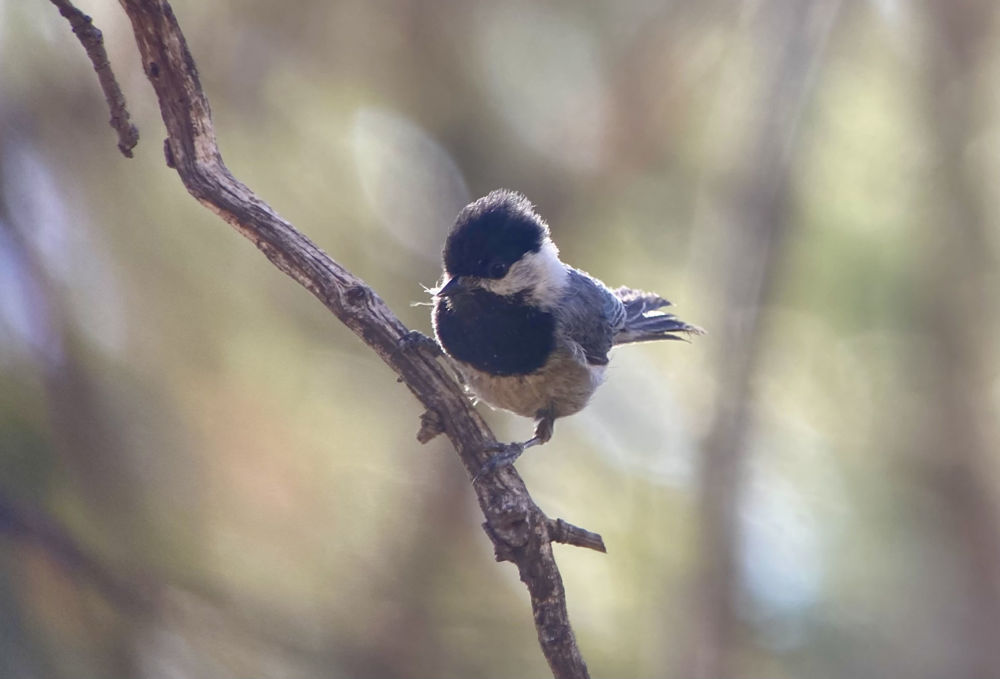 Mexican Chickadee ©Barry Zimmer Despite some searching, we could not find the Spotted Owl at Pinery Campground that sometimes roosts in the canyon. We did, however, add Steller’s Jay, Pygmy Nuthatch, wonderful studies of a pair of Olive Warblers, a pair of localized Black-chinned Sparrows, and a beautiful male Lazuli Bunting to our list. Migrants were everywhere on this day with birds pouring out of the trees all morning long. I estimated an incredible 120 Western Tanagers for the day! A White-nosed Coati was spied by Michelle foraging in a Douglas Fir and allowed prolonged studies. Most amazing was the sighting of a pair of near-mythical Montezuma Quail on our way back down to lunch shortly after noon. We watched them as they froze in place for nearly ten minutes next to the road. After lunch, we headed up to the George Walker House in Paradise to watch the feeders. Juniper Titmice came in quickly, and we had more wonderful studies of Arizona Woodpecker, Scott’s and Hooded orioles, Lazuli Bunting, and Blue Grosbeak. Back down in Portal, Jasper’s feeders yielded a good variety of birds, as well as a Western Diamond-backed Rattlesnake.
Mexican Chickadee ©Barry Zimmer Despite some searching, we could not find the Spotted Owl at Pinery Campground that sometimes roosts in the canyon. We did, however, add Steller’s Jay, Pygmy Nuthatch, wonderful studies of a pair of Olive Warblers, a pair of localized Black-chinned Sparrows, and a beautiful male Lazuli Bunting to our list. Migrants were everywhere on this day with birds pouring out of the trees all morning long. I estimated an incredible 120 Western Tanagers for the day! A White-nosed Coati was spied by Michelle foraging in a Douglas Fir and allowed prolonged studies. Most amazing was the sighting of a pair of near-mythical Montezuma Quail on our way back down to lunch shortly after noon. We watched them as they froze in place for nearly ten minutes next to the road. After lunch, we headed up to the George Walker House in Paradise to watch the feeders. Juniper Titmice came in quickly, and we had more wonderful studies of Arizona Woodpecker, Scott’s and Hooded orioles, Lazuli Bunting, and Blue Grosbeak. Back down in Portal, Jasper’s feeders yielded a good variety of birds, as well as a Western Diamond-backed Rattlesnake. 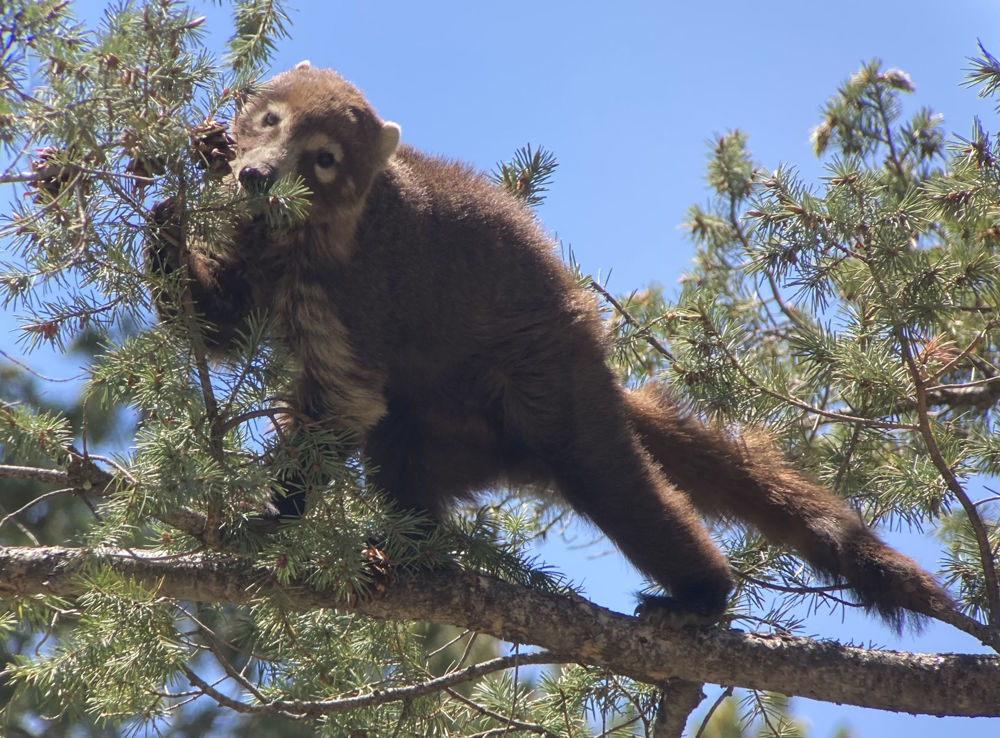 White-nosed Coati ©Barry Zimmer That night we went out owling once again, this time starting in the desert flats below Portal and working our way up into the canyon. A Great Horned Owl sitting on a windmill, prolonged close studies of a Western Screech-Owl, scope studies of a Mexican Whip-poor-will, and a pair of Scaled Quail topped the list. The next morning, we did some desert birding before returning to the highlands around Rustler Park and Barfoot Park. We were, frankly, running out of new birds to look for! Fantastic looks at Bendire’s Thrasher and a pair of Western Bluebirds topped the morning highlights. Migrants were again plentiful with particularly high numbers of tanagers, grosbeaks, and thrushes. Having seen virtually all the hoped-for birds in that area, we returned to Pinery Canyon for a second attempt at the Spotted Owl, but again without success. At lunchtime, we got news of a just arrived White-eared Hummingbird back in Paradise, so we headed there in short order. Luck was on our side, as we had superb studies of this beautiful Mexican rarity.
White-nosed Coati ©Barry Zimmer That night we went out owling once again, this time starting in the desert flats below Portal and working our way up into the canyon. A Great Horned Owl sitting on a windmill, prolonged close studies of a Western Screech-Owl, scope studies of a Mexican Whip-poor-will, and a pair of Scaled Quail topped the list. The next morning, we did some desert birding before returning to the highlands around Rustler Park and Barfoot Park. We were, frankly, running out of new birds to look for! Fantastic looks at Bendire’s Thrasher and a pair of Western Bluebirds topped the morning highlights. Migrants were again plentiful with particularly high numbers of tanagers, grosbeaks, and thrushes. Having seen virtually all the hoped-for birds in that area, we returned to Pinery Canyon for a second attempt at the Spotted Owl, but again without success. At lunchtime, we got news of a just arrived White-eared Hummingbird back in Paradise, so we headed there in short order. Luck was on our side, as we had superb studies of this beautiful Mexican rarity. 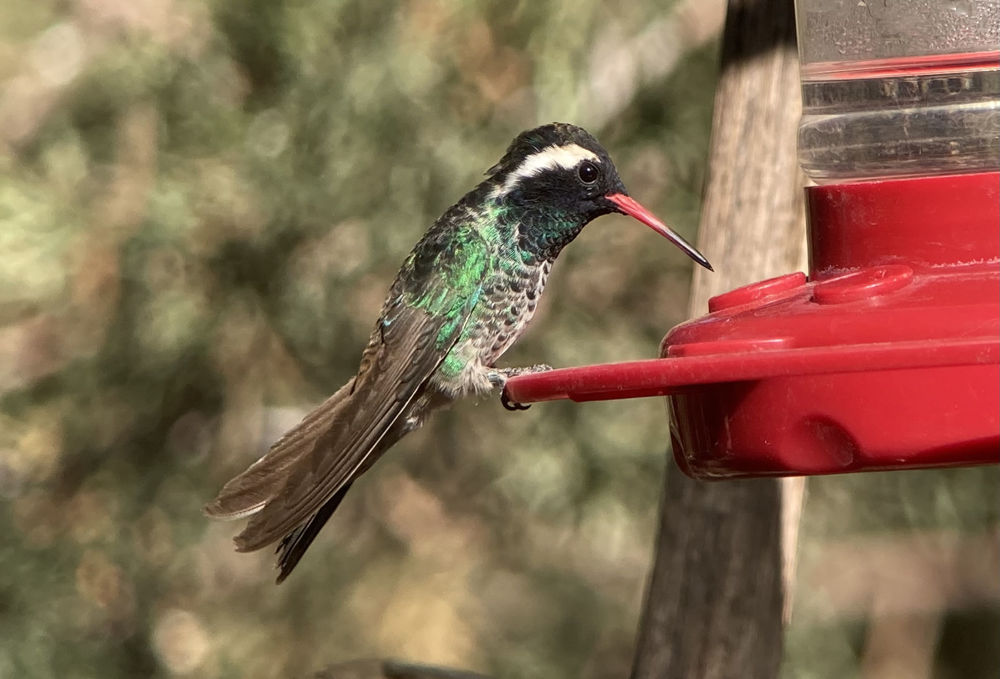 White-eared Hummingbird ©Barry Zimmer The final morning, we started out along the Paradise Road, where we tallied several Woodhouse’s Scrub-Jays and a very close male Black-tailed Gnatcatcher. Another male Elegant Trogon gave wonderful views in South Fork, and incredibly, we had another pair of Montezuma Quail next to the road—this one giving even better studies than the last. We headed over the mountain one final time on our way back to Tucson. Passing through Pinery Canyon, we hoped that the third time was a charm for the Spotted Owl. Our tour mojo continued, as we found the roosting owl within about five minutes of our arrival and had superb scope looks at this rare species! We stopped once again at Cochise Lake in Willcox, where we added two Snowy Plovers. A pair of Chihuahuan Ravens on the edge of town gave us superb looks, including their snow-white neck feathers. For the tour, we tallied an impressive 196 species of birds. We found virtually all of the hoped-for southeastern Arizona specialties, as well as several unexpected rarities. We enjoyed wonderful studies of the iconic Elegant Trogon, saw ten species of hummingbirds (one short of a May tour record) including two Mexican vagrant species, and an impressive seven species of owls. We also had perhaps the most passerine migrants I have ever seen on this tour in 40 years. Southeastern Arizona is simply an amazing birding destination. Additionally, we had an impressive 19 species of mammals and eight species of herps. I can’t wait to come back next year!
White-eared Hummingbird ©Barry Zimmer The final morning, we started out along the Paradise Road, where we tallied several Woodhouse’s Scrub-Jays and a very close male Black-tailed Gnatcatcher. Another male Elegant Trogon gave wonderful views in South Fork, and incredibly, we had another pair of Montezuma Quail next to the road—this one giving even better studies than the last. We headed over the mountain one final time on our way back to Tucson. Passing through Pinery Canyon, we hoped that the third time was a charm for the Spotted Owl. Our tour mojo continued, as we found the roosting owl within about five minutes of our arrival and had superb scope looks at this rare species! We stopped once again at Cochise Lake in Willcox, where we added two Snowy Plovers. A pair of Chihuahuan Ravens on the edge of town gave us superb looks, including their snow-white neck feathers. For the tour, we tallied an impressive 196 species of birds. We found virtually all of the hoped-for southeastern Arizona specialties, as well as several unexpected rarities. We enjoyed wonderful studies of the iconic Elegant Trogon, saw ten species of hummingbirds (one short of a May tour record) including two Mexican vagrant species, and an impressive seven species of owls. We also had perhaps the most passerine migrants I have ever seen on this tour in 40 years. Southeastern Arizona is simply an amazing birding destination. Additionally, we had an impressive 19 species of mammals and eight species of herps. I can’t wait to come back next year! 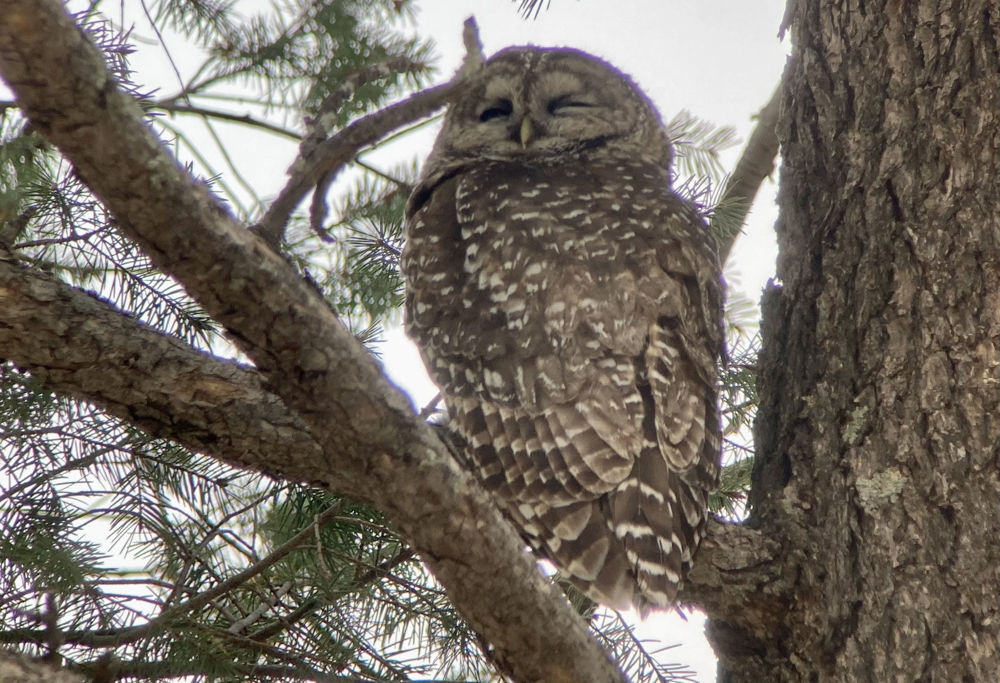 Spotted Owl ©Barry Zimmer FIVE FAVORITE BIRDS: 1. Elegant Trogon (4 votes and 18 points)2. Montezuma Quail (3 votes and 9 points)3. Whiskered Screech-Owl (3 votes and 7 points)4. Red-faced Warbler (2.5 votes and 8 points)5. Spotted Owl (1.5 votes and 5.5 points) A complete list of the birds recorded on our trip can be found at:
Spotted Owl ©Barry Zimmer FIVE FAVORITE BIRDS: 1. Elegant Trogon (4 votes and 18 points)2. Montezuma Quail (3 votes and 9 points)3. Whiskered Screech-Owl (3 votes and 7 points)4. Red-faced Warbler (2.5 votes and 8 points)5. Spotted Owl (1.5 votes and 5.5 points) A complete list of the birds recorded on our trip can be found at:
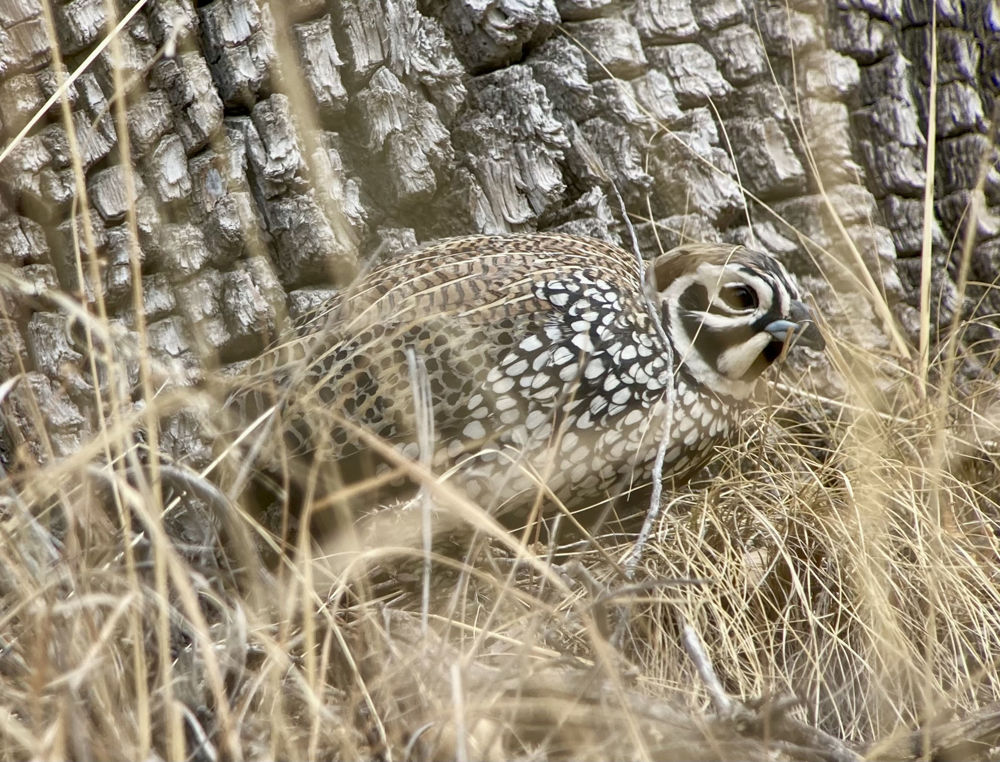 Montezuma Quail ©Barry Zimmer KEY: T = all areas in and around Tucson S = Santa Rita Mountains (Madera Canyon, Box Canyon, Florida Canyon), Green Valley, Sahuarita, Amado N = Nogales, Patagonia, Tubac, Ruby Road H = Huachuca Mountains, Sonoita grasslands C = Chiricahua Mountains, Sulphur Springs Valley, Willcox NM = New Mexico underlined species represent birds of very uncommon occurrence or species which occur regularly but in such low density as to be easily missed bold-faced species indicate birds of rare, casual, or accidental occurrence
Montezuma Quail ©Barry Zimmer KEY: T = all areas in and around Tucson S = Santa Rita Mountains (Madera Canyon, Box Canyon, Florida Canyon), Green Valley, Sahuarita, Amado N = Nogales, Patagonia, Tubac, Ruby Road H = Huachuca Mountains, Sonoita grasslands C = Chiricahua Mountains, Sulphur Springs Valley, Willcox NM = New Mexico underlined species represent birds of very uncommon occurrence or species which occur regularly but in such low density as to be easily missed bold-faced species indicate birds of rare, casual, or accidental occurrence 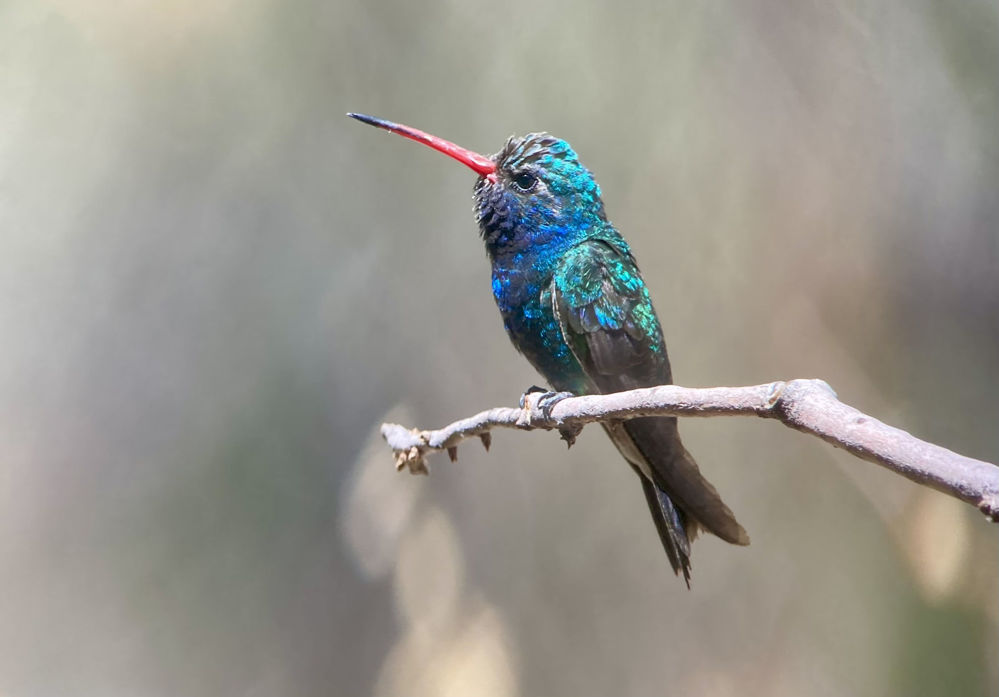 Broad-billed Hummingbird ©Barry Zimmer
Broad-billed Hummingbird ©Barry Zimmer
 Costa's Hummingbird ©Barry Zimmer By mid-morning we were headed to the upper parking area of Madera Canyon in search of the iconic Elegant Trogon. Despite a lengthy hike and some reports of trogon sightings by others, we did not locate one on this day. We did, however, have incredible views of the incomparable Red-faced Warbler (seldom seen low down in this canyon), in addition to other new species such as Dusky-capped Flycatcher, Hammond’s Flycatcher, Western Flycatcher, Swainson’s and Hermit thrushes, and Black-throated Gray and Grace’s warblers. After lunch, we headed up Box Canyon hoping to find the extremely localized and highly-sought Five-striped Sparrow. Luck was on our side, as we had point-blank views of this prize within ten minutes. On our way back to Tucson for a mid-afternoon break, we paused near Sahuarita to look for Harris’s Hawk. We quickly located a family group of four birds in a pine, enjoying nice scope looks, including a copulation by the adults!
Costa's Hummingbird ©Barry Zimmer By mid-morning we were headed to the upper parking area of Madera Canyon in search of the iconic Elegant Trogon. Despite a lengthy hike and some reports of trogon sightings by others, we did not locate one on this day. We did, however, have incredible views of the incomparable Red-faced Warbler (seldom seen low down in this canyon), in addition to other new species such as Dusky-capped Flycatcher, Hammond’s Flycatcher, Western Flycatcher, Swainson’s and Hermit thrushes, and Black-throated Gray and Grace’s warblers. After lunch, we headed up Box Canyon hoping to find the extremely localized and highly-sought Five-striped Sparrow. Luck was on our side, as we had point-blank views of this prize within ten minutes. On our way back to Tucson for a mid-afternoon break, we paused near Sahuarita to look for Harris’s Hawk. We quickly located a family group of four birds in a pine, enjoying nice scope looks, including a copulation by the adults!  Five-striped Sparrow ©Barry Zimmer That evening, we returned to the Santa Rita Mountains for our first owling excursion. On the way, we spied a Crested Caracara (rare here) perched atop a saguaro. Lesser Nighthawks, along with Violet-green Swallows, swarmed over the desert on our way up into the canyon, allowing wonderful views. We topped things off with scope studies of a tiny Elf Owl at its nest and quick, but close, views of a Western Screech-Owl. This was a wonderful first full day! The next day found us back in the Santa Rita Mountains, this time focusing all our efforts on finding a trogon. Our nearly mile-long hike up the canyon was rewarded with the best views ever of this most iconic bird of southeast Arizona. We had a male as close as ten feet at times, and enjoyed watching it for over ten minutes. It would ultimately be voted the favorite bird of the tour! On our way back down the canyon, we stopped again at the Madera Kubo, and this time the rare Berylline Hummingbird showed up in quick order. At nearby Santa Rita Lodge, we tallied an Arizona Woodpecker and a male Bronzed Cowbird.
Five-striped Sparrow ©Barry Zimmer That evening, we returned to the Santa Rita Mountains for our first owling excursion. On the way, we spied a Crested Caracara (rare here) perched atop a saguaro. Lesser Nighthawks, along with Violet-green Swallows, swarmed over the desert on our way up into the canyon, allowing wonderful views. We topped things off with scope studies of a tiny Elf Owl at its nest and quick, but close, views of a Western Screech-Owl. This was a wonderful first full day! The next day found us back in the Santa Rita Mountains, this time focusing all our efforts on finding a trogon. Our nearly mile-long hike up the canyon was rewarded with the best views ever of this most iconic bird of southeast Arizona. We had a male as close as ten feet at times, and enjoyed watching it for over ten minutes. It would ultimately be voted the favorite bird of the tour! On our way back down the canyon, we stopped again at the Madera Kubo, and this time the rare Berylline Hummingbird showed up in quick order. At nearby Santa Rita Lodge, we tallied an Arizona Woodpecker and a male Bronzed Cowbird.  Elegant Trogon ©Barry Zimmer After a superb lunch at Elvira’s in Tubac, we stopped along nearby Bridge Road. Gray Hawk, Tropical Kingbird, countless Phainopeplas, Summer Tanager, and Yellow-breasted Chat were among the many species seen there in the early afternoon. We opted for a brief stop at Las Lagunas de Anza in Nogales before heading to the hotel for a well-deserved break. Green Heron, Gray and Swainson’s hawks, another Tropical Kingbird, Common Yellowthroat, and Song Sparrow were all added to our list. The following morning, we ventured out Ruby Road as far as the entrance to Sycamore Canyon. It was largely quiet along the way with Rock Wren, Rufous-crowned Sparrow, and Canyon Towhee being the only new birds. However, upon arriving at Sycamore Canyon, we found an oak tree that was freshly leafing out, and it was swarming with birds. Eight Townsend’s Warblers, three rare Hermit Warblers, and a stunning male Varied Bunting (thanks Michelle!) topped the list, but that one tree had thirteen species of birds in it! Additionally, a pair of Zone-tailed Hawks soared right overhead!
Elegant Trogon ©Barry Zimmer After a superb lunch at Elvira’s in Tubac, we stopped along nearby Bridge Road. Gray Hawk, Tropical Kingbird, countless Phainopeplas, Summer Tanager, and Yellow-breasted Chat were among the many species seen there in the early afternoon. We opted for a brief stop at Las Lagunas de Anza in Nogales before heading to the hotel for a well-deserved break. Green Heron, Gray and Swainson’s hawks, another Tropical Kingbird, Common Yellowthroat, and Song Sparrow were all added to our list. The following morning, we ventured out Ruby Road as far as the entrance to Sycamore Canyon. It was largely quiet along the way with Rock Wren, Rufous-crowned Sparrow, and Canyon Towhee being the only new birds. However, upon arriving at Sycamore Canyon, we found an oak tree that was freshly leafing out, and it was swarming with birds. Eight Townsend’s Warblers, three rare Hermit Warblers, and a stunning male Varied Bunting (thanks Michelle!) topped the list, but that one tree had thirteen species of birds in it! Additionally, a pair of Zone-tailed Hawks soared right overhead!  Hermit Warbler ©Barry Zimmer Following lunch (and the greatest apple pie in the world!), we opted for a relaxing afternoon at the Paton Hummingbird Center in Patagonia. We quickly landed our primary target, the flashy Violet-crowned Hummingbird, with Ladder-backed Woodpecker, Northern Beardless-Tyrannulet, and a rare Rose-breasted Grosbeak thrown in for good measure. We ended the day with some birding in nearby Harshaw Canyon. Scope views of Thick-billed Kingbird were particularly memorable, but we also had a Gray Hawk on a nest and a migrant Olive-sided Flycatcher. Another great day in the books! Day Five found us back in Patagonia, starting out at the famous Patagonia Roadside Rest Area, where several White-throated Swifts rocketed overhead, while a return to Harshaw Canyon produced a rare sighting of Vaux’s Swift. Heading eastward through the nearby Sonoita Grasslands, we tallied the newly-split Chihuahuan Meadowlark, as well as Horned Lark, a very late Lark Bunting, and many Lark Sparrows. After lunch, we headed to Willcox, where several rarities had been recently reported. We enjoyed an excellent visit there with ten species of shorebirds (including a very rare American Golden Plover, American Avocet, Black-necked Stilt, Baird’s Sandpiper, and Wilson’s and Red-necked phalaropes among others), Mexican Duck, Cinnamon Teal, White-faced Ibis, and Franklin’s Gull. In total, we added twenty species to our rapidly growing list at this site. We rounded out the day with a late afternoon visit to Ash Canyon south of Sierra Vista. There, we found the hoped-for Lucifer Hummingbird in record-breaking time—one minute after arrival. Brilliant Anna’s Hummingbirds, many Broad-tailed Hummingbirds, tons of Western Tanagers, and Bullock’s and Scott’s orioles were among the other more noteworthy species.
Hermit Warbler ©Barry Zimmer Following lunch (and the greatest apple pie in the world!), we opted for a relaxing afternoon at the Paton Hummingbird Center in Patagonia. We quickly landed our primary target, the flashy Violet-crowned Hummingbird, with Ladder-backed Woodpecker, Northern Beardless-Tyrannulet, and a rare Rose-breasted Grosbeak thrown in for good measure. We ended the day with some birding in nearby Harshaw Canyon. Scope views of Thick-billed Kingbird were particularly memorable, but we also had a Gray Hawk on a nest and a migrant Olive-sided Flycatcher. Another great day in the books! Day Five found us back in Patagonia, starting out at the famous Patagonia Roadside Rest Area, where several White-throated Swifts rocketed overhead, while a return to Harshaw Canyon produced a rare sighting of Vaux’s Swift. Heading eastward through the nearby Sonoita Grasslands, we tallied the newly-split Chihuahuan Meadowlark, as well as Horned Lark, a very late Lark Bunting, and many Lark Sparrows. After lunch, we headed to Willcox, where several rarities had been recently reported. We enjoyed an excellent visit there with ten species of shorebirds (including a very rare American Golden Plover, American Avocet, Black-necked Stilt, Baird’s Sandpiper, and Wilson’s and Red-necked phalaropes among others), Mexican Duck, Cinnamon Teal, White-faced Ibis, and Franklin’s Gull. In total, we added twenty species to our rapidly growing list at this site. We rounded out the day with a late afternoon visit to Ash Canyon south of Sierra Vista. There, we found the hoped-for Lucifer Hummingbird in record-breaking time—one minute after arrival. Brilliant Anna’s Hummingbirds, many Broad-tailed Hummingbirds, tons of Western Tanagers, and Bullock’s and Scott’s orioles were among the other more noteworthy species.  Lucifer Hummingbird ©Barry Zimmer The next day, we visited scenic Carr Canyon in the Huachuca Mountains. This is typically my favorite day of the tour, and on this day it did not disappoint. The highlights were almost too numerous to mention, but included Zone-tailed Hawk, Greater Pewee, several Buff-breasted Flycatchers, Hutton’s and Plumbeous vireos, Brown Creeper, Bushtit, Eastern Bluebird, Olive Warbler, Virginia’s Warbler, Grace’s Warbler, Black-throated Gray Warbler, Painted Redstart, and a fabulous Red-faced Warbler from about fifteen feet away!
Lucifer Hummingbird ©Barry Zimmer The next day, we visited scenic Carr Canyon in the Huachuca Mountains. This is typically my favorite day of the tour, and on this day it did not disappoint. The highlights were almost too numerous to mention, but included Zone-tailed Hawk, Greater Pewee, several Buff-breasted Flycatchers, Hutton’s and Plumbeous vireos, Brown Creeper, Bushtit, Eastern Bluebird, Olive Warbler, Virginia’s Warbler, Grace’s Warbler, Black-throated Gray Warbler, Painted Redstart, and a fabulous Red-faced Warbler from about fifteen feet away!  Red-faced Warbler ©Barry Zimmer The afternoon highlights consisted of a relaxing feeder watch in Miller Canyon (adding Blue-throated Mountain-gem among six species of hummingbirds seen; also, the frog pond produced great views of a couple of the highly endangered Chiricahua Leopard Frogs) and a fantastic view of Greater Roadrunner on our third attempt below Ramsey Canyon. After dinner, we had a rather magical owling excursion. It began with nice looks at several Common Poorwills and ended with a Whiskered Screech-Owl right over our heads. We visited Miller Canyon the following morning in search of the vagrant pair of Flame-colored Tanagers that were hanging out at that location. Alas, we could not locate them and settled for more views of Arizona Woodpecker, Red-faced Warbler, Townsend’s Warbler, and Hepatic Tanager, as well as a totally unexpected Black Bear! By late morning we were headed to historic Bisbee for lunch. From there, it was on to the Chiricahua Mountains for the last three days of our trip. Along the way, we made successful stops for both Crissal (#900 for Harold) and Bendire’s (#900 for Nora) thrashers. After settling into our rooms the first afternoon, we ventured up to the high elevations of the range for an owling trip that evening. A Flammulated Owl briefly called but then went silent; we did have a nice Gray Fox on the way back. Most of the next day was spent in the upper elevations of the Chiricahuas. In the morning, we birded the road up to Onion Saddle and down into Pinery Canyon. In quick fashion, we tallied the Mexican Chickadee (only found in this mountain range in the US) at our first stop, as well as a very responsive Northern Pygmy-Owl and a Band-tailed Pigeon.
Red-faced Warbler ©Barry Zimmer The afternoon highlights consisted of a relaxing feeder watch in Miller Canyon (adding Blue-throated Mountain-gem among six species of hummingbirds seen; also, the frog pond produced great views of a couple of the highly endangered Chiricahua Leopard Frogs) and a fantastic view of Greater Roadrunner on our third attempt below Ramsey Canyon. After dinner, we had a rather magical owling excursion. It began with nice looks at several Common Poorwills and ended with a Whiskered Screech-Owl right over our heads. We visited Miller Canyon the following morning in search of the vagrant pair of Flame-colored Tanagers that were hanging out at that location. Alas, we could not locate them and settled for more views of Arizona Woodpecker, Red-faced Warbler, Townsend’s Warbler, and Hepatic Tanager, as well as a totally unexpected Black Bear! By late morning we were headed to historic Bisbee for lunch. From there, it was on to the Chiricahua Mountains for the last three days of our trip. Along the way, we made successful stops for both Crissal (#900 for Harold) and Bendire’s (#900 for Nora) thrashers. After settling into our rooms the first afternoon, we ventured up to the high elevations of the range for an owling trip that evening. A Flammulated Owl briefly called but then went silent; we did have a nice Gray Fox on the way back. Most of the next day was spent in the upper elevations of the Chiricahuas. In the morning, we birded the road up to Onion Saddle and down into Pinery Canyon. In quick fashion, we tallied the Mexican Chickadee (only found in this mountain range in the US) at our first stop, as well as a very responsive Northern Pygmy-Owl and a Band-tailed Pigeon.  Mexican Chickadee ©Barry Zimmer Despite some searching, we could not find the Spotted Owl at Pinery Campground that sometimes roosts in the canyon. We did, however, add Steller’s Jay, Pygmy Nuthatch, wonderful studies of a pair of Olive Warblers, a pair of localized Black-chinned Sparrows, and a beautiful male Lazuli Bunting to our list. Migrants were everywhere on this day with birds pouring out of the trees all morning long. I estimated an incredible 120 Western Tanagers for the day! A White-nosed Coati was spied by Michelle foraging in a Douglas Fir and allowed prolonged studies. Most amazing was the sighting of a pair of near-mythical Montezuma Quail on our way back down to lunch shortly after noon. We watched them as they froze in place for nearly ten minutes next to the road. After lunch, we headed up to the George Walker House in Paradise to watch the feeders. Juniper Titmice came in quickly, and we had more wonderful studies of Arizona Woodpecker, Scott’s and Hooded orioles, Lazuli Bunting, and Blue Grosbeak. Back down in Portal, Jasper’s feeders yielded a good variety of birds, as well as a Western Diamond-backed Rattlesnake.
Mexican Chickadee ©Barry Zimmer Despite some searching, we could not find the Spotted Owl at Pinery Campground that sometimes roosts in the canyon. We did, however, add Steller’s Jay, Pygmy Nuthatch, wonderful studies of a pair of Olive Warblers, a pair of localized Black-chinned Sparrows, and a beautiful male Lazuli Bunting to our list. Migrants were everywhere on this day with birds pouring out of the trees all morning long. I estimated an incredible 120 Western Tanagers for the day! A White-nosed Coati was spied by Michelle foraging in a Douglas Fir and allowed prolonged studies. Most amazing was the sighting of a pair of near-mythical Montezuma Quail on our way back down to lunch shortly after noon. We watched them as they froze in place for nearly ten minutes next to the road. After lunch, we headed up to the George Walker House in Paradise to watch the feeders. Juniper Titmice came in quickly, and we had more wonderful studies of Arizona Woodpecker, Scott’s and Hooded orioles, Lazuli Bunting, and Blue Grosbeak. Back down in Portal, Jasper’s feeders yielded a good variety of birds, as well as a Western Diamond-backed Rattlesnake.  White-nosed Coati ©Barry Zimmer That night we went out owling once again, this time starting in the desert flats below Portal and working our way up into the canyon. A Great Horned Owl sitting on a windmill, prolonged close studies of a Western Screech-Owl, scope studies of a Mexican Whip-poor-will, and a pair of Scaled Quail topped the list. The next morning, we did some desert birding before returning to the highlands around Rustler Park and Barfoot Park. We were, frankly, running out of new birds to look for! Fantastic looks at Bendire’s Thrasher and a pair of Western Bluebirds topped the morning highlights. Migrants were again plentiful with particularly high numbers of tanagers, grosbeaks, and thrushes. Having seen virtually all the hoped-for birds in that area, we returned to Pinery Canyon for a second attempt at the Spotted Owl, but again without success. At lunchtime, we got news of a just arrived White-eared Hummingbird back in Paradise, so we headed there in short order. Luck was on our side, as we had superb studies of this beautiful Mexican rarity.
White-nosed Coati ©Barry Zimmer That night we went out owling once again, this time starting in the desert flats below Portal and working our way up into the canyon. A Great Horned Owl sitting on a windmill, prolonged close studies of a Western Screech-Owl, scope studies of a Mexican Whip-poor-will, and a pair of Scaled Quail topped the list. The next morning, we did some desert birding before returning to the highlands around Rustler Park and Barfoot Park. We were, frankly, running out of new birds to look for! Fantastic looks at Bendire’s Thrasher and a pair of Western Bluebirds topped the morning highlights. Migrants were again plentiful with particularly high numbers of tanagers, grosbeaks, and thrushes. Having seen virtually all the hoped-for birds in that area, we returned to Pinery Canyon for a second attempt at the Spotted Owl, but again without success. At lunchtime, we got news of a just arrived White-eared Hummingbird back in Paradise, so we headed there in short order. Luck was on our side, as we had superb studies of this beautiful Mexican rarity.  White-eared Hummingbird ©Barry Zimmer The final morning, we started out along the Paradise Road, where we tallied several Woodhouse’s Scrub-Jays and a very close male Black-tailed Gnatcatcher. Another male Elegant Trogon gave wonderful views in South Fork, and incredibly, we had another pair of Montezuma Quail next to the road—this one giving even better studies than the last. We headed over the mountain one final time on our way back to Tucson. Passing through Pinery Canyon, we hoped that the third time was a charm for the Spotted Owl. Our tour mojo continued, as we found the roosting owl within about five minutes of our arrival and had superb scope looks at this rare species! We stopped once again at Cochise Lake in Willcox, where we added two Snowy Plovers. A pair of Chihuahuan Ravens on the edge of town gave us superb looks, including their snow-white neck feathers. For the tour, we tallied an impressive 196 species of birds. We found virtually all of the hoped-for southeastern Arizona specialties, as well as several unexpected rarities. We enjoyed wonderful studies of the iconic Elegant Trogon, saw ten species of hummingbirds (one short of a May tour record) including two Mexican vagrant species, and an impressive seven species of owls. We also had perhaps the most passerine migrants I have ever seen on this tour in 40 years. Southeastern Arizona is simply an amazing birding destination. Additionally, we had an impressive 19 species of mammals and eight species of herps. I can’t wait to come back next year!
White-eared Hummingbird ©Barry Zimmer The final morning, we started out along the Paradise Road, where we tallied several Woodhouse’s Scrub-Jays and a very close male Black-tailed Gnatcatcher. Another male Elegant Trogon gave wonderful views in South Fork, and incredibly, we had another pair of Montezuma Quail next to the road—this one giving even better studies than the last. We headed over the mountain one final time on our way back to Tucson. Passing through Pinery Canyon, we hoped that the third time was a charm for the Spotted Owl. Our tour mojo continued, as we found the roosting owl within about five minutes of our arrival and had superb scope looks at this rare species! We stopped once again at Cochise Lake in Willcox, where we added two Snowy Plovers. A pair of Chihuahuan Ravens on the edge of town gave us superb looks, including their snow-white neck feathers. For the tour, we tallied an impressive 196 species of birds. We found virtually all of the hoped-for southeastern Arizona specialties, as well as several unexpected rarities. We enjoyed wonderful studies of the iconic Elegant Trogon, saw ten species of hummingbirds (one short of a May tour record) including two Mexican vagrant species, and an impressive seven species of owls. We also had perhaps the most passerine migrants I have ever seen on this tour in 40 years. Southeastern Arizona is simply an amazing birding destination. Additionally, we had an impressive 19 species of mammals and eight species of herps. I can’t wait to come back next year!  Spotted Owl ©Barry Zimmer FIVE FAVORITE BIRDS: 1. Elegant Trogon (4 votes and 18 points)2. Montezuma Quail (3 votes and 9 points)3. Whiskered Screech-Owl (3 votes and 7 points)4. Red-faced Warbler (2.5 votes and 8 points)5. Spotted Owl (1.5 votes and 5.5 points) A complete list of the birds recorded on our trip can be found at:
Spotted Owl ©Barry Zimmer FIVE FAVORITE BIRDS: 1. Elegant Trogon (4 votes and 18 points)2. Montezuma Quail (3 votes and 9 points)3. Whiskered Screech-Owl (3 votes and 7 points)4. Red-faced Warbler (2.5 votes and 8 points)5. Spotted Owl (1.5 votes and 5.5 points) A complete list of the birds recorded on our trip can be found at:
https://ebird.org/tripreport/376529
Explore the photo gallery. Read the description for the next departure of this tour. View Barry Zimmer's upcoming tour schedule. ITINERARY: May 14 - afternoon visit to Sonoran Desert Museum (31 species) May 15 – Desert Meadow Park in Green Valley, Madera Canyon (Madera Kubo, upper canyon trails),Box Canyon, Abrego Road in Green Valley, I-19; evening owling (88 species; 92 total) May 16 – Santa Rita experimental range, Madera Canyon (upper canyon trails, Madera Kubo, Santa Rita Lodge), Amado Sewage Pond, Bridge Road & Ron Morris Park in Tubac, Las Lagunas de Anza (80 species; 113 total) May 17 – Ruby Road to Sycamore Canyon, Paton’s Center for Hummingbirds in Patagonia, Harshaw Canyon Road (73 species; 128 total) May 18 –Patagonia (Roadside Rest Area & Sonoita Avenue), Harshaw Canyon Road, Sonoita Grasslands, Cochise Lake & Twin Lakes golf course in Willcox, Ash Canyon (105 species; 158 total) May 19 – Ramsey Canyon Road briefly, then Carr Canyon (Reef Townsite Campground and beyond) the rest of the morning, Beatty’s Guest Ranch in Miller Canyon, Hereford, evening owling in Brown Canyon & Carr Canyon (66 species; 165 total) May 20 – Miller Canyon (Beatty’s Guest Ranch & upper canyon trail), drive to Chiricahuas with stop at Whitewater Draw and southern end of Sulphur Springs Valley and roadside birding, grounds of Cave Creek Ranch; evening owling to Barfoot Park (78 species; 171 total) May 21 –upper elevations of Chiricahua Mountains (Pinery Canyon, Onion Saddle, Rustler Park), afternoon to George Walker House in Paradise, Jasper’s feeders; evening owling to desert flats, Rodeo and lower Cave Creek Canyon (87 species; 188 total) May 22 –Portal Road to 4 Bar Cottages, upper elevations of the Chiricahuas to Rustler Park &Pinery Canyon; George Walker House in Paradise, Cave creek Canyon; evening owling return to Barfoot Park & Pinery Canyon (75 species; 190 total) May 23 –Paradise Road, South Fork of Cave Creek Canyon, Sunny Flats Campground, over the upper elevations of the Chiricahuas (Onion Saddle & Pinery Canyon), Cochise Lake & Twin Lakes Golf Course in Willcox, Benson WTP (91 species; 196 total) May 24 - departures for home (196 total species) Montezuma Quail ©Barry Zimmer KEY: T = all areas in and around Tucson S = Santa Rita Mountains (Madera Canyon, Box Canyon, Florida Canyon), Green Valley, Sahuarita, Amado N = Nogales, Patagonia, Tubac, Ruby Road H = Huachuca Mountains, Sonoita grasslands C = Chiricahua Mountains, Sulphur Springs Valley, Willcox NM = New Mexico underlined species represent birds of very uncommon occurrence or species which occur regularly but in such low density as to be easily missed bold-faced species indicate birds of rare, casual, or accidental occurrence
Montezuma Quail ©Barry Zimmer KEY: T = all areas in and around Tucson S = Santa Rita Mountains (Madera Canyon, Box Canyon, Florida Canyon), Green Valley, Sahuarita, Amado N = Nogales, Patagonia, Tubac, Ruby Road H = Huachuca Mountains, Sonoita grasslands C = Chiricahua Mountains, Sulphur Springs Valley, Willcox NM = New Mexico underlined species represent birds of very uncommon occurrence or species which occur regularly but in such low density as to be easily missed bold-faced species indicate birds of rare, casual, or accidental occurrence  Broad-billed Hummingbird ©Barry Zimmer
Broad-billed Hummingbird ©Barry Zimmer

